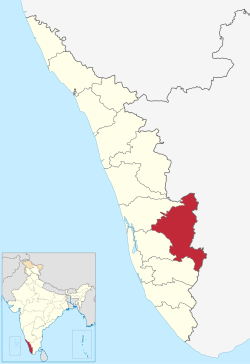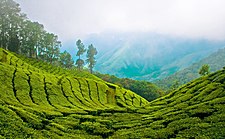
Back ادوكي Arabic ادوكى ARZ इडुक्की जिला Bihari ইদুক্কি জেলা Bengali/Bangla Idukki (distrito) CEB Idukki (Distrikt) German Distrito de Idukki Spanish Idukki barrutia Basque بخش ایدوکی Persian Idukkin piirikunta Finnish
Idukki District | |
|---|---|
|
Clockwise from top: Sunrise at Munnar, Periyar National Park, Idukki Dam, Tea plantation on Cardamom Hills, Mattupetty Dam, and Anamudi peak. | |
| Nickname: The Spice Garden of Kerala[1] | |
 Location in Kerala | |
| Coordinates: 9°51′N 76°56′E / 9.85°N 76.94°E | |
| Country | |
| State | Kerala |
| Headquarters | Painavu |
| Subdivisions |
|
| Government | |
| • Collector | Sheeba George IAS |
| • District Police Chief | Vishnu Pratheep T.K IPS |
| Area | |
| • Total | 4,612 km2 (1,781 sq mi) |
| • Rank | 1st |
| Elevation | 1,200 m (3,900 ft) |
| Population (2018)[2] | |
| • Total | 1,093,156 |
| • Density | 251/km2 (650/sq mi) |
| Languages | |
| • Official | Malayalam, English[3] |
| • Minority | Tamil |
| Time zone | UTC+5:30 (IST) |
| ISO 3166 code | IN-KL |
| Vehicle registration |
|
| HDI (2005) | |
| Website | www |
Idukki (ഇടുക്കി; IPA: [iɖukːi] ) is one of the 14 districts in the Indian state of Kerala in the southwest of the country.[5][6] It is the largest district in Kerala and lies amid the Cardamom Hills of Western Ghats in Kerala. Idukki district contains two municipal towns – Kattappana and Thodupuzha, and five taluks.
The district was constituted on 26 January 1972, by taking Peerumade, Udumbanchola, Devikulam taluks of the former High Range division from Kottayam district and the Thodupuzha taluk from Ernakulam district.[7] Its division was previously headquartered at Kottayam city but moved to Kuyilimala near Painavu and Cheruthoni in June 1976. Malayalam and English are the two official administrative languages in the district.[3] Tamil is the second most spoken language in Idukki district after Malayalam.[8]
Around 66% of Kerala's power needs come from various Hydroelectric Power Projects in Idukki district.[1] Numerous cash crops and spices are cultivated throughout the district, making it The Spice Garden of Kerala.[1] A significant area in the district is protected as reserved forests and wildlife sanctuaries.[1] The Periyar River is a major river that originates and flows through Idukki. The Pamba River is another important river that originates from Idukki district.
Though it is the largest district in the region in terms of area, it has the lowest population density among the districts of Kerala. There are only two municipalities in the district and the urban population is comparatively much lower than the rural population, due to its mountainous nature. The 2,695 metres (8,842 ft) high peak of Anamudi, which is also the highest point of elevation in India outside the Himalayas, lies in the northern portion of the district of Idukki.[9] The Idukki Dam is one of the highest arch dams in Asia.[10]
The major tourism destination of Idukki is Munnar.
- ^ a b c d "The Spice Garden of Kerala". National Informatics Centre, Ministry of Electronics and Information Technology, Government of India. Retrieved 20 June 2022.
- ^ Annual Vital Statistics Report – 2018 (PDF). Thiruvananthapuram: Department of Economics and Statistics, Government of Kerala. 2020. p. 55. Archived from the original (PDF) on 2 November 2021. Retrieved 25 November 2020.
- ^ a b "The Kerala Official Language (Legislation) Act, 1969" (PDF).
- ^ "Kerala | UNDP in India". UNDP.
- ^ "Idukki | India". Encyclopedia Britannica. Retrieved 24 October 2021.
- ^ Idukki District (Variant – V) at GEOnet Names Server, United States National Geospatial-Intelligence Agency
- ^ "History of Idukki District". District Idukki, Government of India.
- ^ "Table C-16 Population by Mother Tongue: Kerala". www.censusindia.gov.in. Registrar General and Census Commissioner of India.
- ^ "Anamudi". Kerala Tourism. Retrieved 20 June 2022.
- ^ "Idukki Arch Dam". Government of Kerala. Retrieved 20 June 2022.






